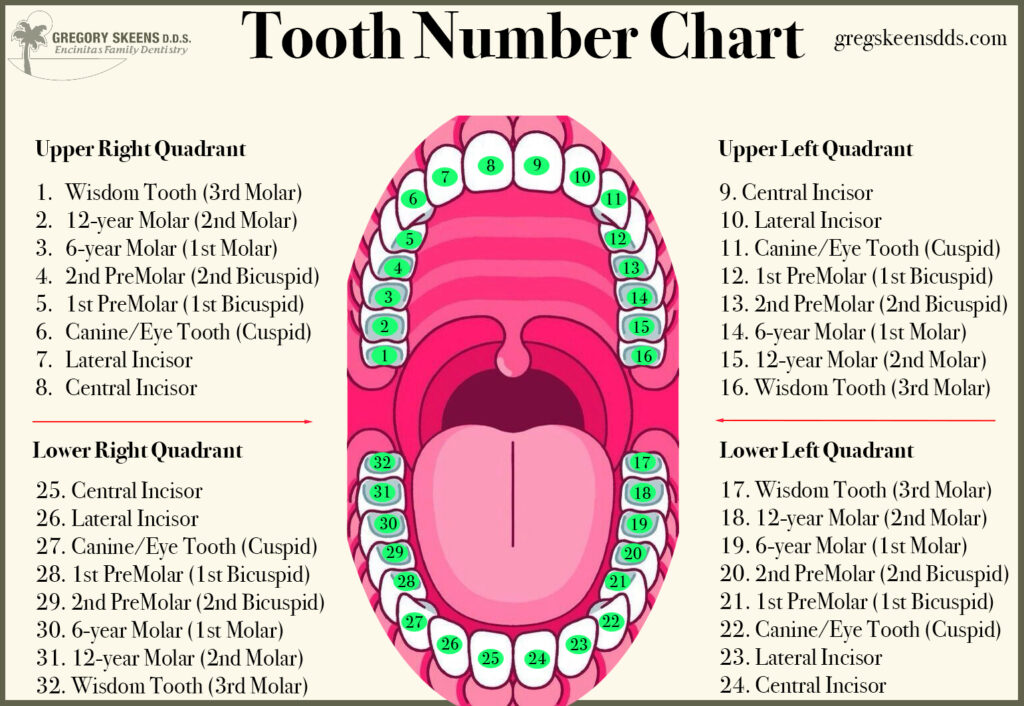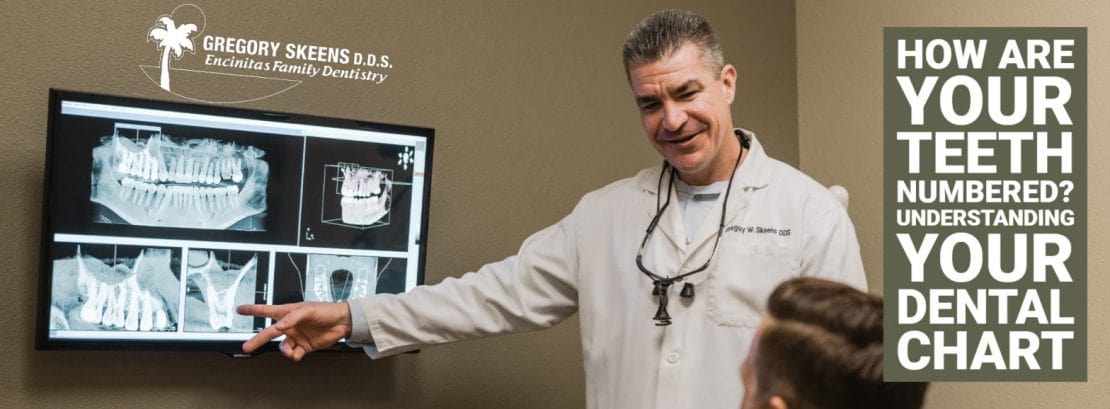Trying to interpret your dental x-rays can be very confusing, so it’s no surprise that many people are afraid of the dentist. The good news is, it’s easy to learn how to read your dental chart, commonly called a tooth number chart.
With this guide to how your teeth are numbered, you can feel more confident and prepared ahead of your next important dental procedure.
Tooth Number Chart

Types of Human Teeth
Adults have 32 teeth , which can be broken down into four categories:
- Molars
Our molars are responsible for helping us thoroughly chew our food. A healthy set of teeth will have 12 molars arranged in the back of the mouth. Molars are grown to be extremely strong to grind and crush textured foods for safe swallowing. Wisdom teeth are a type of molar which emerge at the very back of the gums in some dental patients. - Premolars
Also known as bicuspids, our premolars are slightly less strong than our molars. Each side of the mouth holds 4 premolars, or 8 premolars in total. Bicuspids usually have a flat surface to help tear food apart and assist the molars with food liquefaction. - Incisors
Our 8 frontmost teeth (4 on the top and 4 on the bottom) are referred to as incisors. This tooth type is the first to emerge in infants as early as 6 months old. The center two incisors are known as “central”, while the two on either side are known as “lateral”. Our incisors are designed for biting and gripping food for chewing. - Canines
Healthy mouths contain 4 canine teeth which flank our incisors (2 on the top and 2 on the bottom). Canine teeth are distinctly sharper than our other teeth in order to effectively tear food into chewable chunks. Our canine teeth can have a more animalistic appearance, and some evolutionists believe humans developed canines to be able to consume meat.
Dental Chart of Teeth Numbers
Now that we are familiar with the four types of teeth, we can easily pinpoint the location of each tooth in our mouths. A healthy human mouth will have symmetrically arranged teeth so that teeth on opposing sides of the mouth will be of the same type.
How Are Teeth Numbered?
Teeth 1-16
Our first 16 teeth are located at the top of the mouth. We start with Tooth #1, a molar on the back right side of our mouths known as the upper right quadrant. Dentists and dental hygienists will count through to Tooth #16, located in the upper left quadrant.
TOP TEETH |
|||
| Tooth Number | Type of Tooth | Quadrant | Opposite Tooth |
| 1 | Molar | Upper Right | 16 |
| 2 | Molar | Upper Right | 15 |
| 3 | Molar | Upper Right | 14 |
| 4 | Premolar | Upper Right | 13 |
| 5 | Premolar | Upper Right | 12 |
| 6 | Canine | Upper Right | 11 |
| 7 | Incisor | Upper Right | 10 |
| 8 | Incisor | Upper Right | 9 |
| 9 | Incisor | Upper Left | 8 |
| 10 | Incisor | Upper Left | 7 |
| 11 | Canine | Upper Left | 6 |
| 12 | Premolar | Upper Left | 5 |
| 13 | Premolar | Upper Left | 4 |
| 14 | Molar | Upper Left | 3 |
| 15 | Molar | Upper Left | 2 |
| 16 | Molar | Upper Left | 1 |
Teeth 17-32
We continue counting our bottom teeth from Tooth #17 found in the lower left quadrant. Then, we work our way back to the lower right quadrant, ending at Tooth #32.
BOTTOM TEETH |
|||
| Tooth Number | Type of Tooth | Quadrant | Opposite Tooth |
| 17 | Molar | Lower Left | 32 |
| 18 | Molar | Lower Left | 31 |
| 19 | Molar | Lower Left | 30 |
| 20 | Premolar | Lower Left | 29 |
| 21 | Premolar | Lower Left | 28 |
| 22 | Canine | Lower Left | 27 |
| 23 | Incisor | Lower Left | 26 |
| 24 | Incisor | Lower Left | 25 |
| 25 | Incisor | Lower Right | 24 |
| 26 | Incisor | Lower Right | 23 |
| 27 | Canine | Lower Right | 22 |
| 28 | Premolar | Lower Right | 21 |
| 29 | Premolar | Lower Right | 20 |
| 30 | Molar | Bottom Right | 19 |
| 31 | Molar | Bottom Right | 18 |
| 32 | Molar | Bottom Right | 17 |
What Are Primary Teeth?
As you may already know, human beings grow two sets of teeth in their lifetime. As infants and young children, we develop 20 individual primary teeth, also known as baby teeth, milk teeth, or deciduous teeth. Baby teeth usually start to erupt from the gums in infants aged 6 months. Normally, our upper and lower incisors are the first teeth that appear (and also the first teeth to fall out).
Primary teeth are noticeably smaller than adult teeth. The roots are also thinner and shorter so they can easily grow out of the gums to make way for our permanent teeth.
Children usually retain their primary teeth until the age of 6 or 7, when they begin to loosen and shed. Primary teeth should be monitored by parents throughout childhood because they will determine your child’s ability to speak and chew food into adulthood.
When Do Permanent Teeth Come In?
Once a child begins to shed their primary teeth, their permanent adult teeth will continue to grow until the age of 21 when they have completely emerged.
As stated above, a healthy adult mouth will consist of 32 permanent teeth. Our adult teeth are much larger and stronger than the primary teeth we nurse in childhood, but we must care for them with the same amount of attention. Since the roots of our permanent teeth are much longer and thicker, improper care can lead to a tremendous amount of tooth pain.
Since we do not grow any more teeth after our permanent teeth have settled in, chronic dental issues need to be addressed by a dental professional.
Dr. Skeens can help you read your dental chart.
Dr. Skeens and our dental team at Encinitas Family Dentistry would be happy to help you navigate your personal dental chart. We’re dedicated to providing the information you need about each and every one of your teeth to help you make educated decisions about your dental care. We offer a number of important dental services, including:
- Dental Whitening
- Teeth Irrigation
- X-Ray Exams
- Screening for Gum Disease
- Oral Cancer Screening
- Tooth Decay Evaluation
- And much more.
We want to help you achieve a radiant smile. Call us at (760) 944-9288 , and let us show you how!

